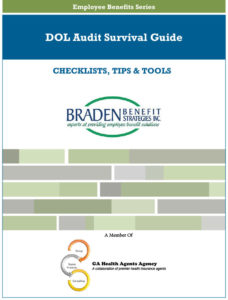Many employers are tired, frustrated and disenchanted with their current options. We understand that.
Other healthcare and PR professionals also understand. PwC’s Health Research Institute stated: “Employers must pursue strategies that not only strengthen their bottom line but better equip workers to make informed health decisions, or they will likely pay a high cost in the long run” (Medical Cost Trend: Behind the Numbers 2016).
The ultimate answer is to develop and implement a benefits package that meets the demographic, strategic and financial needs of the employer, while maintaining or enhancing employee satisfaction of the benefit plans offered.
Additional plans may be offered either as an employer-paid benefit or as an employer-sponsored benefit that is paid for by each participating employee on a voluntary basis. These benefit plans are specific to the employer’s strategic and financial needs.
Is this affordable? What will it cost?
Analysis
Before we can begin to build your benefit program, we must first understand the particular challenges you are facing at your business. Here are some questions we like to discuss with new clients:
• What are your goals for your benefits?
o Are they a “must have” to attract and retain the right type of employee?
o Are they in place to avoid the ACA penalty?
o Are they valued by your employees?
o Are they meeting your expectations?
• What is driving your cost increases?
o Once identified, how do we address the increases?
• What factors are determining the premium increases? This may require some research, but common factors are:
o The high cost of weight.
o 30% – 30% – 30%.
o Rock along.
• Are the benefits offered consistent with your industry?
o Perhaps you’re offering too much or too little.
o Perhaps you’re paying too much or too little.
o What is the optimal employee cost share?
• What has your company done to maintain premium cost increases? For instance, have you:
o Changed plan designs, shifting more financial exposure to employees should they have an illness?
o Instituted programs to address the issues increasing the use of healthcare?
o Instituted educational programs?
o Changed carriers?
• What is the analytic process?
o When a copay or deductible is changed, what effect does this have on the premium and on the employee cost sharing?
Braden Benefit Strategies is able to work with your data and complete a risk assessment analysis.
Design
Employers need a benefit strategy. Raising deductibles or changing plan designs annually is not a strategy, but rather a Band-Aid approach.
Braden Benefit Strategies, Inc., is experienced in creating strategies to address the specifics of your company’s rising healthcare costs. We work directly with you and your employees, creating unique programs to address the factors driving your healthcare loss ratios (the number by which your future premium increases are based). Factors uncovered in the analysis are discussed above.
Here is some information about a few of the programs we instituted at companies that had specific situations driving up their healthcare costs:
o The high cost of weight.
o 30% – 30% – 30%.
o Rock along.
Recently, Rich Novack, market president at Cigna, said he would make all health insurance plans contingent on employees being proactively involved in their healthcare. Put another way, health insurance is a benefit. If a company is going to give you (an employee) this benefit, you need to do X, Y and Z. Such requirements might include annual physicals, treadmill tests at age 40 and above, annual completion of a health risk assessment (HRA), or a colonoscopy at age 50. Any number of items might be included in this list, which would be determined by the analysis above and directed at controlling ongoing healthcare cost increases.
Health insurance carrier Humana only offers its employees high deductible plans with health savings accounts. There is no copay or coinsurance employee cost sharing until after the annual deductible has been met. This program is more than eight years old and is embraced by Humana’s employees for the containment of their annual premium increase, which has been minimal.
To read Humana’s full story, read Dynamic Signal’s article, How Humana Mobilized Employees to Promote a Healthier Lifestyle.
Encouraging employees to take steps to maintain their health, incorporating wellness initiatives specific to the individual, and educating employees on how their policies work are all vital keys to controlling long-term costs.
Unum’s Employee Education and Enrollment Survey, conducted by Harris Interactive in December 2012, reminds employers why it’s important to increase employee cost-sharing. Adding employee-paid voluntary benefits (for instance, after an accident or a critical illness, such as cancer) helps employees minimize their financial exposure. Using voluntary benefits helps keep employer benefit packages competitive without impacting the bottom-line. A company’s benefit offering and plan design should revolve around the findings of this study.
Implementation
All the planning in the world is wasted if employees are not educated. They need to know what is covered, how their plan works, where to find answers to their questions, how to process a claim and much more – not only during open enrollment meetings but throughout the year.
Here are five ways to help your employees make the best use of benefits:
1. Help them understand what’s being offered.
2. Make plans customizable to meet individual needs.
3. Offer ancillary benefits to boost financial security.
4. Talk about benefits outside open enrollment.
5. Make it easy to sign up.
Here at Braden Benefit Strategies, Inc., we provide our clients and their employees with regular information designed to engage employees in their healthcare. We take the work off the company’s administrative person.

-Open enrollment meetings.
-Employee benefit booklets.
-Employee enrollment and on-boarding.
-Electronic access to the employee’s individual selections.
-Client-specific open enrollment meetings recorded for later use.
-DOL annual employee notices. Please contact us to request your own copy of our DOL Audit Survival Guide.
Glass Door ran an article that stated: “Employees who feel well-educated about their benefits are more likely to go the extra mile for their employers, believe their employers care about them, and stay with the same company even if offered comparable pay and benefits elsewhere (Rieva Lesonsky, “Are You Educating Your Employees About Your Employee Benefits?”, Glass Door, June 30, 2014).




